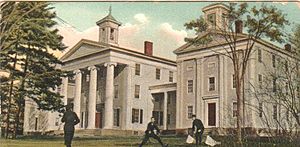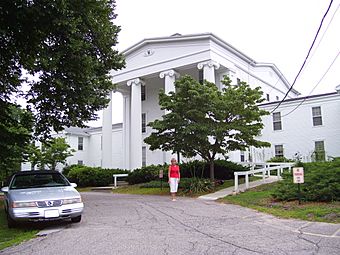Pentecostal Collegiate Institute (Rhode Island) facts for kids

Pentecostal Collegiate Institute campus (c. 1905)
|
|
| Type | Private |
|---|---|
| Active | 1902–1918 |
| Affiliation | Association of Pentecostal Churches of America Pentecostal Church of the Nazarene |
| President | Fred J. Shields (1919) |
| Principal | William F. Albrecht (1902-1904) D.C. Thatcher (1904) W.H. Daniels (1905) Walter C. Kinsey (1905-1906) E.E. Angell (1906-1913) Martha Curry (1913-1914) J.C. Bearse (1914-1916) A.R. Archibald (1916-1917) J.E.L. Moore (1917-1919) |
| Location | , , |
| Campus | Rural |
|
Pentecostal Collegiate Institute (Rhode Island)
|
|

Pentecostal Collegiate Institute main building in 2008
|
|
| Location | Scituate, Rhode Island |
|---|---|
| Built | 1839 |
| Architect | Russell Warren (architect) |
| Architectural style | Greek Revival |
| NRHP reference No. | 78003446 |
| Added to NRHP | March 29, 1978 |
The Pentecostal Collegiate Institute (PCI) was a school in North Scituate, Rhode Island. It was open from September 1902 to 1918. This school was special because it taught both boys and girls. It also welcomed students from different Christian groups.
PCI was run by its own board. It first worked with the Association of Pentecostal Churches of America. After 1915, the Church of the Nazarene took over. Today, it is seen as an early version of Eastern Nazarene College.
Contents
Where Was the School Located?
The Pentecostal Collegiate Institute was at 29 Institute Lane in North Scituate, Rhode Island. It was on a hill between Route 6 and Route 116. You could see it from the Village Green.
The Story of the School
The Pentecostal Collegiate Institute actually started in Saratoga Springs, New York, in 1900. It was called the Pentecostal Collegiate Institute and Bible Seminary.
Moving to Rhode Island
In 1902, there were disagreements with the school's leader, Rev. Lyman C. Pettit. So, the church group decided to close the New York school. They moved the school to North Scituate, Rhode Island. This village is about 10 miles (16 km) west of Providence, Rhode Island.
The church group had to raise money to buy a new campus. This was because the old property in New York was owned by the former leader. The school also had money problems, which made it hard to find leaders and set clear goals.
Early Leaders and Challenges
William F. Albrecht (1902-1904)
In June 1902, Rev. William F. Albrecht and Rev. Fred A. Hillery found a new place for the school. They chose the old Lapham Institute buildings. These buildings had been empty since 1876.
The main building was large and had three stories. It was built in 1839 by architect Russell Warren. It had two wings with classrooms, offices, and dining areas. There were also separate buildings for boys' and girls' dorms.
Hillery bought the property for $4,500. The school was officially set up in Rhode Island on April 17, 1903. Members of the church group sold shares to pay for the purchase and repairs.
Albrecht, some teachers, and students worked hard to fix up the buildings. Classes started on September 16, 1902. Many students and teachers from New York did not move. So, the school stopped offering a full college program.
For several years, PCI taught elementary and high school students. It also had a program to prepare students for college.
Important Teachers
It was hard to find enough students, money, and teachers. Olive May Winchester joined the faculty. She was a graduate of Radcliffe College. She taught at PCI until 1909. She also traveled to raise money for the school.
Another teacher was Jesse B. Mowry. He also worked as a school superintendent and a state forestry commissioner.
The first class graduated from PCI in June 1903. Estella "Stella" Adelia Reynolds was the first graduate. Her father was an important church leader.
Albrecht left his role as principal in August 1904. He later faced health challenges.
Short-Term Principals (1904-1906)
After Albrecht, there were a few short-term leaders:
- Rev. David C. Thatcher (1904)
- Rev. William Haven Daniels (1905)
- Rev. Walter C. Kinsey (1905-1906)
Growth Under E.E. Angell (1906-1913)
Rev. Ernest E. Angell became principal in 1906. By 1907, the number of students grew to eighty-four. This showed the school was recovering after its move.
In 1907, the church groups joined to form the Pentecostal Church of the Nazarene. This new group supported PCI, but it didn't give much extra money. Other new schools also needed financial help.
To help students earn money for school, Angell started the Pentecostal Trade Schools in 1908. This program taught skills like broom making, sewing, and printing. Students could work to pay for their education. PCI also added business and shorthand classes. Angell resigned in 1913 due to stress and poor health.
New Leaders and Academic Growth
Martha Curry (1913-1914)
Rev. Martha "Mattie" Eva Curry, a well-known church speaker, was the interim principal for the 1913-1914 school year.
J.C. Bearse (1914-1916)
Rev. Joseph Caldwell Bearse led PCI from 1914 to 1916. He worked to improve the school's academic programs. He hired well-qualified teachers. Bearse had studied at Brown and Boston universities.
In 1914, Olive Winchester returned to PCI. She had earned a special degree from Glasgow University. She became the head of the Theology department and vice-principal. Bertha Munro, who led the high school program, was also a top student from Brown University.
Despite these strong teachers, the school still struggled with money. Bearse wrote about how hard it was to pay bills and keep the school running.
A.R. Archibald (1916-1917)
Dr. Albert R. Archibald, a Methodist minister, was the interim principal for the 1916-1917 school year. Olive Winchester left in 1916 to continue her studies in California.
J.E.L. Moore (1917-1919)
In 1917, Rev. John Edgar Littleton Moore became principal. His main goal was to pay off the school's debt. He needed about $50,000 to clear the debt and prepare PCI for college-level work. Moore successfully raised the money by December 1918.
While leading PCI, Moore also earned a master's degree from Boston University. In 1918, the school's board decided to make Moore president. They also voted to start a full four-year college program. The school's name was changed to Eastern Nazarene College.
Eastern Nazarene College Moves
In 1918, the board decided to move the college to Wollaston, Massachusetts. In 1919, Moore left to become president of another college.
Fred J. Shields (1919)
In 1919, Fred J. Shields became president for one year.
What Happened to the Campus Later?
Watchman Industrial School and Camp (1923–1974)
In 1920, the campus was sold to Rev. William S. Holland. He had started the Watchman Industrial School in Providence in 1908. This school mainly served African-American students. He moved his school to the former PCI campus in 1923.
The school faced financial problems and went bankrupt in 1938 during the Great Depression. However, Rev. Holland and his wife continued to run a summer camp for African-American youth there until 1974.
The school for Black youths had a tough time. There were suspicious fires in 1924 and 1926. Newspapers at the time reported that the local Ku Klux Klan might have set them. A former student also remembered seeing a cross burned on the lawn in the 1930s.
In the late 1970s, local people worked to repair the buildings. The campus was added to the National Register of Historic Places in 1978.
Scituate Commons (1983 to Today)
Since 1983, the main building has been used as Scituate Commons. It is now an apartment complex. The inside has changed a lot for apartments. However, the outside still looks much like the original design. In 1985, the site was recognized as an important historical place for African-American history in the state.
Images for kids





